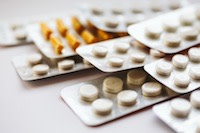What is Baqsimi and how does it work?
Medically reviewed by Dr Sultan Linjawi, Endocrinologist & Diabetes Specialist — November 2025

DO YOU WANT TO GET YOUR DIABETES UNDER THE BEST CONTROL?
Click the program that best describes your situation.
What is Baqsimi nasal powder?
Baqsimi is a new portable, dry nasal spray of powdered glucagon developed by Eli Lilly pharmaceuticals. This is a ready to use form of glucagon that doesn’t require any mixing before use. It was the first FDA approved powder version of glucagon which can help to increase blood glucose levels in people who are having a hypoglycaemic event.
Each packet contains 2 cartridges for use in the management of severe hypoglycaemia when a person requires the help of another person.
Baqsimi doesn’t need to be refrigerated and can be stored in temperatures up to 30 degrees Celsius (86 degrees Fahrenheit). Baqsimi can also be used in people with diabetes from four years and older.
When should Baqsimi glucagon be used?
Baqsimi glucagon is designed to be used as an emergency measure for the treatment of hypglycaemia (low blood sugar level) when a person with diabetes is unable to help themselves or eat sugar containing foods safely.
At what age can Baqsimi glucagon be used?
Baqsimi glucagon has been approved to be used in adults and children aged 4 and older. It is likely further studies will examine the safety in children under 4 years in the future.
How is Baqsimi nasal powder used?
Baqsimi comes in a single 3mg dose which is absorbed in the nose. It does not need to be inhaled. Baqsimi is a powder which is administered into the nose of someone having a hypoglycaemic event from a single-use dispenser.

How long does Baqsimi take to work?
Similar to glucagon injected into the muscle, nasal Baqsimi takes about 5-10 minutes to start to work with blood sugars starting to rise by 15 minutes. This will seem like a very long time in an emergency situation and it is why often an ambulance will need to called.
What are the side effects of Baqsimi nasal powder?
Common side effects of Baqsimi nasal powder include:
- nausea
- vomiting
- headache
Local symptoms from administration:
- upper respiratory tract irritation
- runny nose, nasal discomfort, nasal congestion, cough, and nosebleed
- watery eyes
- eye redness
- sneezing
The common side effects are similar to intramuscular injected glucagon. They tend to completely resolve within a couple of hours.
Recovering from the Baqsimi spray – what to do next?
After a person recovers following the use of the Baqsimi spray, try to feed them some fast-acting glucose, for example fruit juice, followed by longer acting carbohydrates, for example fruit, bread, or crackers.
Where should I keep Baqsimi nasal powder?
It’s important to keep some Baqsimi with your other diabetes supplies in case of an emergency. It’s a good idea to have more than one emergency kit, for example having one on you while you’re away from home, as well as keeping some with close relatives or friends, or in places where you and your child spend a lot of time. If you keep any Baqsimi with friends, family, at school or work, make sure that other people know where the Baqsimi is stored are and how and when to use it.
Some examples of where emergency dose of Baqsimi can be kept include:
For children:
- at school, for example the nurse’s office or administration office
- at the day care or childcare centre
- with a babysitter
- with a sporting coach
- at the home of relatives
For adults
- at the workplace
- at the homes of close friends and relatives
- with you when you’re travelling
- with a sporting coach
What is glucagon?
Glucagon is a hormone which is produced by the alpha cells of the pancreas. When blood glucose levels fall too low (hypoglycaemia), glucagon raises the levels of glucose in the blood by converting stored glycogen in the liver to glucose. People with type 1 diabetes release limited glucagon in response to a low blood sugar (hypoglycaemia)
Insulin is also hormone but is produced by the beta cells of the pancreas. The action of insulin is to decrease levels of glucose in the blood stream.
Glucagon’s effects are the opposite to insulin and both of these hormones work together to keep our blood glucose levels balanced and at a safe range.
What does glucagon do in the body? How does glucagon affect blood glucose levels?
Glucagon is released to stop blood glucose levels from becoming too low (hypoglycaemia), the pancreas will release glucagon which can stimulate the liver to release glucose, giving our cells an important source of energy. Glucose and insulin are two hormones, released from the pancreas, that work together to keep our blood glucose levels in a safe range.
Glucagon can also be released by the pancreas when the body needs additional or extra glucose, for example during vigorous or intense exercise.
The action of glucagon includes to:
- Stimulate the liver to break down glycogen (the stored form of glucose) which can be released into the bloodstream as glucose
- Activate gluconeogenesis, which is the process of converting amino acids into glucose, which can also be used for energy. This process occurs when glucose stores become low
- Decrease fatty acid synthesis by breaking down stored fat from adipose tissue and the liver into free fatty acids, which can also be used as energy by the body’s cells when required
It’s important to note that glucose is the body’s preferred energy source.
How can Baqsimi help someone with diabetes?
Severe hypoglycaemia can occur when a person’s blood glucose levels fall to a level where they become confused or unconscious. The person may also suffer from other symptoms that require assistance to be treated. People who have diabetes and use insulin as part of their diabetes management, are at an increased risk of severe hypoglycaemia, also referred to as severe low blood glucose levels. Baqsimi works to increase blood glucose levels by signalling to the liver to release store glucose into the blood stream. Baqsimi has the opposite effect to insulin. As mentioned, Baqsimi can treat hypoglycaemia in people with diabetes who are four years and older.
What are the symptoms of low blood glucose levels (hypoglycaemia)?
The symptoms of low blood glucose levels, also called hypoglycaemia, can vary from person to person. Low blood glucose levels is more common in people with diabetes. The symptoms of hypoglycaemia can be mild, for example sweating or feeling hungry, or they can be severe, for example passing out or fainting.
Early symptoms of hypoglycaemia include:
- sweating or shaking
- feeling hungry
- feeling worried
- light headedness
If left untreated, symptoms of hypoglycaemia can become serious. This includes:
- a headache, blurry vision, or feeling dizzy
- feeling weak or having trouble walking
- confusion or not thinking clearly
- passing out/ fainting
Risk factors for low blood glucose levels
There are some risk factors for hypoglycaemia. These include:
- Older age
- Longer duration of diabetes diagnosis
- Inconsistent meal timing, including missed meals and low carbohydrate meals
- History of hyperglycaemia, particularly a recent history of severe hypoglycaemia
- Exercise
- Alcohol consumption
What are the ideal blood glucose levels?
Blood glucose levels are measured in millimoles per litre of blood (mmol/L) or milligrams per decilitre of blood (mg/dL) depending on which area of the world you live in. Blood glucose level targets also differ depending on your age, how long you have had diabetes for, what types of medications you are taking, and if you have any other medical conditions in addition to diabetes. Your doctor will take off of this into consideration when determining what your blood glucose level targets are.
Normal blood glucose levels are between 4.0-7.8mmol/L or 72-140mg/dL.
| mmol/L | mg/dL | |
|---|---|---|
| Before meals | 4-8 mmol/L |
72-145 mg/dL |
| After meals | less than 10mmol/L | 180 mg/dL |
| mmol/L | mg/dL | |
|---|---|---|
| Before meals | 6-8 mmol/L |
106-145 mg/dL |
| After meals | 6-10mmol/L | 106-180 mg/dL |
Looking for more diabetes videos?
Check out our latest diabetes videos for more content.
More Articles on Diabetes Treatments
For more information about different Diabetes Treatments, please follow the links below.
Oral Medications for Diabetes
- Starting on Metformin. What you need to know.
- Benefits of Metformin… A Wonder Drug?
- Metformin in Pregnancy. Is it safe?
- Metformin and diarrhoea.
- Vitamin B12 deficiency and diabetes.
- What is an SGLT2 inhibitor? It's a novel way to lower blood sugars, lose weight and maybe live longer.
- Rybelsus (Semaglutide) - A new oral medication to treat Type 2 Diabetes.
---
Insulin for Diabetes
- What is Ryzodeg insulin and how do I use it?
- Fiasp insulin. Fast acting insulin aspart.
- Managing Diabetes with Insulin: Is it necessary?
- Lantas. Solostar insulin glargine.
---
Injections for Diabetes
- What is Trulicity (Dulaglutide) and how does it work?
- Ozempic (Semaglutide) is a new treatment for type 2 diabetes.
- Xultophy 100/3.6 - Type 2 diabetes medication - Benefits, Side Effects and How to Use It.
- What is glucagon and how can a glucagon kit help someone with diabetes?
---
Other Medications for Diabetes
Frequently Asked Questions
What is Baqsimi?
Baqsimi is a ready-to-use intranasal (dry-powder) glucagon used to rapidly raise blood glucose during severe hypoglycaemia. Each device contains a single 3 mg dose and does not require injection or refrigeration.
When should Baqsimi be used?
Baqsimi is used in emergencies when someone with diabetes has severe hypoglycaemia and cannot safely self-treat with oral carbohydrate. It is given by a helper.
Who can use Baqsimi?
Baqsimi is approved for adults and for children aged 4 years and older.
How do you use Baqsimi?
Each device delivers one 3 mg dose into one nostril. The person does not need to inhale—the powder is absorbed through the nasal lining. Devices are single-use only.
How quickly does Baqsimi work?
Blood glucose typically begins to rise within 10–15 minutes, similar to injectable glucagon. Call emergency services if needed.
What are the common side effects of Baqsimi?
Possible effects include nausea, vomiting, headache, nasal irritation, runny or blocked nose, cough, sneezing, watery eyes, or mild nosebleeds.
What should be done after the person wakes up?
Once alert and able to swallow, give fast-acting carbohydrate followed by longer-acting carbohydrate to reduce the risk of the low glucose recurring.
Where should Baqsimi be stored?
Baqsimi can be stored at room temperature (up to about 30°C / 86°F). Keep it in an easily accessible location and ensure family, friends, or carers know how to use it.
What is glucagon?
Glucagon is a natural hormone made by the pancreas that raises blood glucose by triggering the liver to release stored glucose.
How does glucagon raise blood glucose?
It stimulates glycogen breakdown (glycogenolysis) and glucose production (gluconeogenesis), helping reverse severe hypoglycaemia.
How does Baqsimi help in diabetes?
Baqsimi rapidly raises glucose when a person using insulin becomes confused, unconscious, or unable to self-treat due to severe hypoglycaemia.
What are the symptoms of low blood glucose?
Symptoms may include shaking, sweating, hunger, anxiety, dizziness, blurred vision, confusion, difficulty walking, and loss of consciousness in severe cases.







